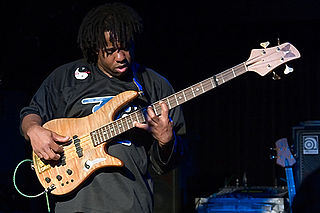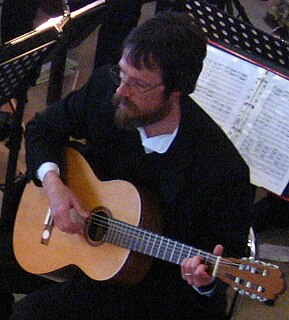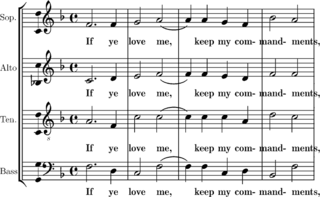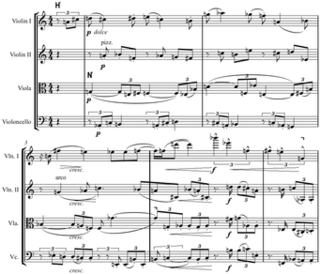
The Classical period was an era of classical music between roughly 1730 and 1820.

Music is the art of arranging sounds in time to produce a composition through the elements of melody, harmony, rhythm, and timbre. It is one of the cultural universal aspects of all human societies. General definitions of music include common elements such as pitch, rhythm, dynamics, and the sonic qualities of timbre and texture. Different styles or types of music may emphasize, de-emphasize or omit some of these elements. Music is performed with a vast range of instruments and vocal techniques ranging from singing to rapping; there are solely instrumental pieces, solely vocal pieces and pieces that combine singing and instruments. The word derives from Greek μουσική ; see § Etymology and glossary of musical terminology.

In music performances, rhythm guitar is a technique and role that performs a combination of two functions: to provide all or part of the rhythmic pulse in conjunction with other instruments from the rhythm section ; and to provide all or part of the harmony, i.e. the chords from a song's chord progression, where a chord is a group of notes played together. Therefore, the basic technique of rhythm guitar is to hold down a series of chords with the fretting hand while strumming or fingerpicking rhythmically with the other hand. More developed rhythm techniques include arpeggios, damping, riffs, chord solos, and complex strums.

A melody, also tune, voice or line, is a linear succession of musical tones that the listener perceives as a single entity. In its most literal sense, a melody is a combination of pitch and rhythm, while more figuratively, the term can include successions of other musical elements such as tonal color. It may be considered the foreground to the background accompaniment. A line or part need not be a foreground melody.

American march music is march music written and/or performed in the United States. Its origins are those of European composers borrowing from the military music of the Ottoman Empire in place there from the 16th century. The American genre developed after the British model during the colonial and Revolutionary periods, then later as military ceremonials and for civilian entertainment events.

In music, monophony is the simplest of musical textures, consisting of a melody, typically sung by a single singer or played by a single instrument player without accompanying harmony or chords. Many folk songs and traditional songs are monophonic. A melody is also considered to be monophonic if a group of singers sings the same melody together at the unison or with the same melody notes duplicated at the octave. If an entire melody is played by two or more instruments or sung by a choir with a fixed interval, such as a perfect fifth, it is also said to be monophony. The musical texture of a song or musical piece is determined by assessing whether varying components are used, such as an accompaniment part or polyphonic melody lines.

A pipe band is a musical ensemble consisting of pipers and drummers. The term pipes and drums, used by military pipe bands is also common.

A bassline is the term used in many styles of music, such as jazz, blues, funk, dub and electronic, traditional music, or classical music for the low-pitched instrumental part or line played by a rhythm section instrument such as the electric bass, double bass, cello, tuba or keyboard.

Accompaniment is the musical part which provides the rhythmic and/or harmonic support for the melody or main themes of a song or instrumental piece. There are many different styles and types of accompaniment in different genres and styles of music. In homophonic music, the main accompaniment approach used in popular music, a clear vocal melody is supported by subordinate chords. In popular music and traditional music, the accompaniment parts typically provide the "beat" for the music and outline the chord progression of the song or instrumental piece.
In jazz, comping is the chords, rhythms, and countermelodies that keyboard players, guitar players, or drummers use to support a musician's improvised solo or melody lines. It is also the action of accompanying, and the left-hand part of a solo pianist.

A rhythm section is a group of musicians within a music ensemble or band that provides the underlying rhythm, harmony and pulse of the accompaniment, providing a rhythmic and harmonic reference and "beat" for the rest of the band. The rhythm section is often contrasted with the roles of other musicians in the band, such as the lead guitarist or lead vocals whose primary job is to carry the melody.
Song structure is the arrangement of a song, and is a part of the songwriting process. It is typically sectional, which uses repeating forms in songs. Common forms include bar form, 32-bar form, verse–chorus form, ternary form, strophic form, and the 12-bar blues. Popular music songs traditionally use the same music for each verse or stanza of lyrics. Pop and traditional forms can be used even with songs that have structural differences in melodies. The most common format in modern popular music is introduction (intro), verse, pre-chorus, chorus, verse, pre-chorus, chorus, bridge, verse, chorus and outro. In rock music styles, notably heavy metal music, there is usually one or more guitar solos in the song, often found after the middle chorus part. In pop music, there may be a guitar solo, or a solo may be performed by a synthesizer player or sax player.
A modal frame in music is "a number of types permeating and unifying African, European, and American song" and melody. It may also be called a melodic mode. "Mode" and "frame" are used interchangeably in this context without reference to scalar or rhythmic modes. Melodic modes define and generate melodies that are not determined by harmony, but purely by melody. A note frame, is a melodic mode that is atonic, or has an unstable tonic.

Jazz harmony is the theory and practice of how chords are used in jazz music. Jazz bears certain similarities to other practices in the tradition of Western harmony, such as many chord progressions, and the incorporation of the major and minor scales as a basis for chordal construction. In jazz, chords are often arranged vertically in major or minor thirds, although stacked fourths are also quite common. Also, jazz music tends to favor certain harmonic progressions and includes the addition of tensions, intervals such as 9ths, 11ths, and 13ths to chords. Additionally, scales unique to style are used as the basis of many harmonic elements found in jazz. Jazz harmony is notable for the use of seventh chords as the basic harmonic unit more often than triads, as in classical music. In the words of Robert Rawlins and Nor Eddine Bahha, "7th chords provide the building blocks of jazz harmony."

In music, homophony is a texture in which a primary part is supported by one or more additional strands that flesh out the harmony. One melody predominates while the other parts play either single notes or an elaborate accompaniment. This differentiation of roles contrasts with equal-voice polyphony and monophony. Historically, homophony and its differentiated roles for parts emerged in tandem with tonality, which gave distinct harmonic functions to the soprano, bass and inner voices.

Jazz improvisation is the spontaneous invention of melodic solo lines or accompaniment parts in a performance of jazz music. It is one of the defining elements of jazz. Improvisation is composing on the spot, when a singer or instrumentalist invents melodies and lines over a chord progression played by rhythm section instruments and accompanied by drums. Although blues, rock, and other genres use improvisation, it is done over relatively simple chord progressions which often remain in one key.
In music, harmonization is the chordal accompaniment to a line or melody: "Using chords and melodies together, making harmony by stacking scale tones as triads".
The term "four-part harmony" refers to music written for four voices, or for some other musical medium—four musical instruments or a single keyboard instrument, for example—for which the various musical parts can give a different note for each chord of the music.

In music, Hauptstimme or Hauptsatz is the main voice, chief part; i.e., the contrapuntal or melodic line of primary importance, in opposition to Nebenstimme. Nebenstimme or Seitensatz is the secondary part; i.e., a secondary contrapuntal or melodic part, always occurring simultaneously with, and subsidiary to, the Hauptstimme. The practice of marking the primary voice within the musical score/parts was invented by Arnold Schoenberg.
Traditional sub-Saharan African harmony is a music theory of harmony in Sub-Saharan Africa music based on the principles of homophonic parallelism, homophonic polyphony, counter melody and ostinato-variation. Polyphony is common in African music and heterophony is a common technique as well. Although these principles of traditional African music are of Pan-African validity, the degree to which they are used in one area over another varies. Specific techniques that used to generate harmony in Africa are the "span process", "pedal notes", "Rhythmic harmony", "harmony by imitation", and "scalar clusters".

 Play (help·info)
Play (help·info)












